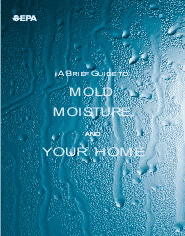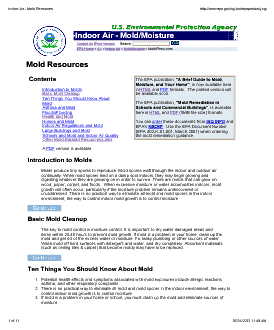 |
 |
|||||
|
||||||
| Ten Things You Should Know About Mold | |
| 1. | Potential health effects and symptoms associated with mold exposures include allergic reactions, asthma, and other respiratory complaints |
| 2. | There is no practical way to eliminate all mold and mold spores in the indoor environment; the way to control indoor mold growth is to control moisture |
| 3. | If mold is a problem in your home or school, you must clean up the mold and eliminate sources of moisture |
| 4. | Fix the source of the water problem or leak to prevent mold growth. |
| 5. | Reduce indoor humidity (to 30-60% ) to decrease mold growth by: venting bathrooms, dryers, and other moisture-generating sources to the outside; using air conditioners and de-humidifiers; increasing ventilation; and using exhaust fans whenever cooking, dishwashing, and cleaning |
| 6. | Clean and dry any damp or wet building materials and furnishings within 24-48 hours to prevent mold growth. |
| 7. | Clean mold off hard surfaces with water and detergent, and dry completely. Absorbent materials such as ceiling tiles, that are moldy, may need to be replaced |
| 8. | Prevent condensation: Reduce the potential for condensation on cold surfaces (i.e., windows, piping, exterior walls, roof, or floors) by adding insulation. |
| 9. | In areas where there is a perpetual moisture problem, do not install carpeting (i.e., by drinking fountains, by classroom sinks, or on concrete floors with leaks or frequent condensation). |
| 10. | Molds can be found almost anywhere; they can grow on virtually any substance, providing moisture is present. There are molds that can grow on wood, paper, carpet, and foods |
| For more detailed information see the PDF files below | |
| Click here to go back to: |
| Specific Information: | Elaine can help you with all your real estate needs. | Max's Dispatch |
Colorado Housing Types and Styles |
|
|
|
Coldwell Banker |
Relocating?
Contact Elaine For Your Also, lots of information at |
|




